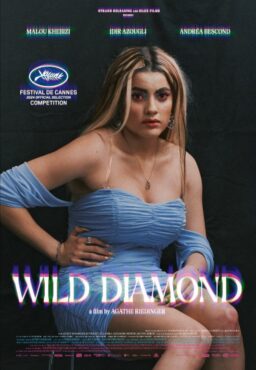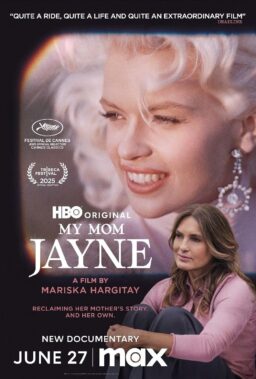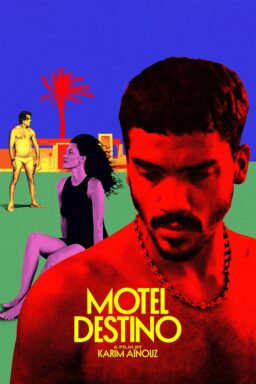
The light and the landscape.
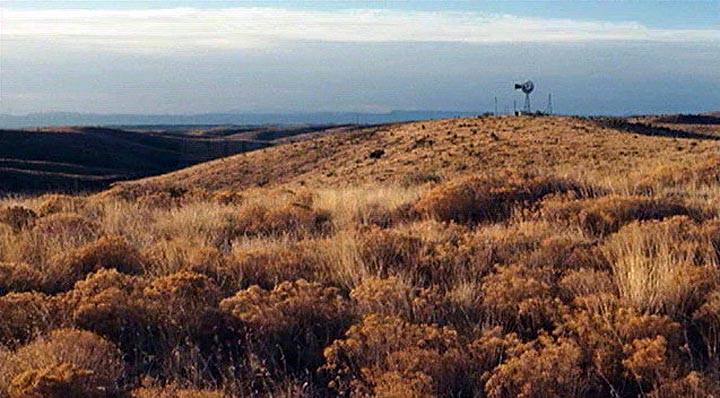
Signs of man.
I was sheriff of this county when I was twenty-five. Hard to believe. Grandfather was a lawman. Father too. Me and him was sheriff at the same time, him in Plano and me here. I think he was pretty proud of that. I know I was.
Some of the old-time sheriffs never even wore a gun. A lot of folks find that hard to believe…. You can’t help but compare yourself against the old timers. Can’t help but wonder how they would’ve operated these times….
— Sheriff Ed Tom Bell (Tommy Lee Jones)
The land is black, swallowed in the shadows. The sky is beginning to glow orange and blue. This is Genesis, the primordial landscape of “No Country for Old Men.” We may think we’re looking at a sunset at first, but the next few shots show a progression: The sky lightens, the sun rises above the horizon to illuminate a vast Western expanse. No signs of humanity are evident. And then, a distant windmill — a mythic “Once Upon a Time in the West” kind of windmill. So, mankind figures into the geography after all. A barbed-wire fence cuts through a field. The camera, previously stationary, stirs to life, and pans (ostensibly down the length of the fence) to find a police car pulled over on the shoulder of a highway. There’s law out here, too.

Boundaries.

The law. (Do these images look sterile or “technical” to you?)
Light, land, man, boundaries, law. Each image builds subtly on the one(s) before it, adding incrementally to our picture of the territory we’re entering. The establishment of this location — a passing-through stretch of time and space, between where you’ve been and where you’re going, wherever that may be — seeps into your awareness. Not a moment is wasted, but the compositions have room to breathe, along with the modulations of Tommy Lee Jones’ voice, the noises in the air, and Carter Burwell’s music-as-sound-design. The movie intensifies and heightens your senses. Light is tangible, whether it’s sunlight or fluorescent. Blades of grass sing in the wind. Ceiling fans whir (not so literally or Symbolically as in “Apocalypse Now“). Milk bottles sweat in the heat. Ventilation ducts, air conditioners and deadbolt housings rumble, hiss and roar.
“To me, style is just the outside of content, and content the inside of style, like the outside and the inside of the human body—both go together, they can’t be separated.”
— Jean-Luc Godard
“No Country for Old Men” has been called a “perfect” film by those who love it and those who were left cold by it. Joel and Ethan Coen have been praised and condemned for their expert “craftsmanship” and their “technical” skills — as if those skills had nothing to do with filmmaking style, or artistry; as if they existed apart from the movie itself. Oh, but the film is an example of “impeccable technique” — you know, for “formalists.” And the cinematography is “beautiful.” Heck, it’s even “gorgeous.” …
But what do those terms mean if they are plucked out of the movie like pickles from a cheeseburger? How is something “beautiful” apart from what it does in the film? (See uncomprehending original-release reviews of “Barry Lyndon” and “Days of Heaven,” for example, in which the “beautiful” was treated as something discrete from the movie itself.) When somebody claims that a movie overemphasizes the “visual” — whether they’re talking about Stanley Kubrick or Terrence Malick or the Coens — it’s a sure sign that they’re not talking about cinema, but approaching film as an elementary school audio-visual aid. When critics (and viewers) refer to the filmmakers’ application of “craft,” “technique,” and “style” (can these things be applied, casually or relentlessly, with a spatula?) without consideration of how these expressions function in the movie, we’re all in trouble. A composition, a cut, a dissolve, a movement — they’re all manifestations of craft (or skill), technique (the systematic use of skill), style (artistic expression).

How salty was my beautiful then… Hey, I specifically asked for a regular cheeseburger, hold the ketchup and no “style”! What does the “craft” (not Kraft) taste like? Isn’t the “technique” also part of the texture?
It’s the old Cartesian schism between body and mind, only aestheticized into an illusory (and impossible) split between form and content, style and meaning, craft and art. You may as well try to take the VistaVision out of “The Searchers” and put it in a bowl, extricate the editing and hang it on the shower rod, remove the John Ford and place it over there, next to the radiator.
Which brings us back to the opening of “No Country for Old Men” and the process of putting the pieces together; losing or following a trail (of blood, of crime, of one’s father and the “old-timers”), navigating an uneasy passage between past and future. It feels like, and it is, what the movie is “about.”
Sheriff Bell has been pondering these bewildering changes and portents, in voiceover, as the movie’s landscapes have unfolded:
…The crime you see now, it’s hard to even take its measure. It’s not that I’m afraid of it. I always knew you had to be willing to die to even do this job — not to be glorious. But I don’t want to push my chips forward and go out and meet something I don’t understand.
You can say it’s my job to fight it but I don’t know what it is anymore. More than that, I don’t want to know. A man would have to put his soul at hazard. He would have to say, OK, I’ll be part of this world….
“OK, I’ll be part of this world.” Those words, the end of Sheriff Bell’s introduction, resonate throughout the movie — a world in which one’s life or death may be determined by a coin toss (a mix of luck and chance and, perhaps, fate), and where one’s soul is at hazard by choosing to engage with it. At least, that’s the way Sheriff Bell sees it. And he wants to opt out.
Everything ahead can be traced to its origins in these opening moments: characters chasing or haunted by forces they don’t understand, meeting up with destinies they didn’t see coming. And it doesn’t matter whether they were looking for them or trying to evade them.
Spoilers follow.
“It’s a dangerous thing to say what a picture is. I don’t like pictures that are one genre only.”
— David Lynch
I’ve used the term “existential thriller” (and/or “epistemological thriller”) to describe movies such as “Chinatown” and “Caché.” It’s a useful term because it can be used across genres and it describes the nature of the “thrills” the movie has in store. “Chinatown” is also a period American detective noir and “Caché” is a modern French intellectual puzzle and “No Country for Old Men” is a contemporary Texas Western chase movie, but they’re all inquiries into the nature of knowledge and existence. They all ask: “What do we know and how do we know it?” Is there a more worthy or essential question?

Recorded on the floor.
At the station, a deputy is on the phone, describing the mysterious “oxygen tank” thing his arrestee was toting. Behind him, out of focus in the background, is Anton Chigurh (“shi-GUR,” Javier Bardem), the man he’s talking about, who silently rises and moves forward. The deputy hangs up and, in the very same motion, the prisoner lowers his hands over the lawman’s head, choking him with his handcuffs. As the two fall back onto the linoleum floor, the shock of the moment is amplified by the expression on Chigurh’s face: His icy glare is aimed not at the man he’s strangling but at the ceiling. He’s not even looking at the man he’s killing, even as the handcuffs cut into the deputy’s neck and Chigurh’s own wrists. The struggle is recorded on the institutional linoleum tiles, a frenzy of black heel marks like an Abstract-Expressionist painting. Man’s violence always leaves its traces on the ground.
It doesn’t much matter what Chigurh is, and even less who he is. He’s not a character (say, a compulsive murderer who acts to gratify his primal psycho-sexual needs). He’s a catalyst, who represents different things to different people: evil, chaos, “the ultimate badass.” Chigurh, with the nearly vowel-less-sounding, unpronounceable name, is a Western figure of mythical stature, like Clint Eastwood’s “Pale Rider” or The Man With No Name in Sergio Leone’s trilogy — or Frank Booth (Dennis Hopper) or Mystery Man (Robert Blake) in David Lynch’s movies.
Chigurh is indeed a “psychopathic killer” (of whoever or whatever gets in the way of his relentless quest), but he’s also the shadow coming across the desert toward Llewelyn Moss (Josh Brolin) as he’s up on the ridge hunting antelope with a telescopic rifle, and the specter of which Sheriff Bell says, “it’s hard to even take its measure.” His “principles” (as one character describes them) are completely beyond the laws, and the comprehension, of civilized men.
Chigurh sees himself, however, as destiny personified. He is simply the Reaper, who does what must be done… because that’s what he does. The way he sees it, he is not the one responsible for the decision to kill or not kill. There are rules and he must enforce them, if only because he’s the only one who understands them (as far as he’s concerned). So, he doesn’t choose to kill or not kill; but if fate puts someone in his way, then so be it.

Call it.

The crinkling.
With chilling clarity, Chigurh addresses the fate of a folksly roadside gas-station proprietor: “What’s the most you ever lost on a coin toss?… Call it.” The befuddled man protests that he doesn’t understand “what it is we’re callin for here,” that he “didn’t put nothin up.”
“Yes you did. You’ve been puttin it up your whole life. You just didn’t know it. You know what date is on this coin? …1958. It’s been traveling 22 years to get here. And now it’s here. And it’s either heads or tails and you have to say. Call it.”
As far as Chigurh is concerned, he’s just the coin, the means. The toss, and the call, those are beyond his control — and, frankly, beyond his concern. (Touch of genius: Note how effectively the uncrinkling of the candy wrapper on the counter adds to the tension of this scene. Chigurh tightens his fist, then lets go. The rest just happens.)
Bell isn’t talking about his job, and he’s not being fatalistic. Unlike Chigurh, he’s human, and he’s seen enough human nature to know that we laugh in recognition of horror and absurdity, maybe even in the moment we find ourselves on the brink of the abyss. It’s not an inappropriate response, and contrary to the claims of some of the Coens’ critics, it doesn’t automatically signal approval of murder, or denial of responsibility. Chigurh himself doesn’t laugh. Laughter requires a form of empathy that he doesn’t possess. Chigurh is by no means the focus of “No Country For Old Men” (it’s more about the other characters’ responses to his presence), but he bothers some people because they don’t know who he is or what he represents. And that’s just fine. Ask yourself, “What does he seek?” (in the words of his movie-killer antithesis, the cannibal psychologist Dr. Hannibal Lecter)… and where does that get you? He seeks $2 million in a leather satchel. As Joel Coen once said to me in an interview about “Barton Fink“: “The question is: Where would it get you if something that’s a little bit ambiguous in the movie is made clear? It doesn’t get you anywhere.” Sometimes, if certain questions don’t appear to have an answer, maybe that’s enough of an answer. Or maybe it’s a superfluous question.

A single motion.

Boots off the floor.
Chigurh often mirrors his victims before he kills them. They face him and they face their own mortality, eye-to-eye. He often violates their space before he violates their flesh, and it’s deeply disturbing: the handcuffs around the neck, the tube to the head of the motorist, his shadow darkening the hall space under Llewelyn’s door, feet on the bed in the hotel room of his nemesis Carson Wells (Woody Harrelson). Wells is dead as soon as Chigurh looks away from him, at the ringing phone, where the man he’s really stalking is on the other end of the line.
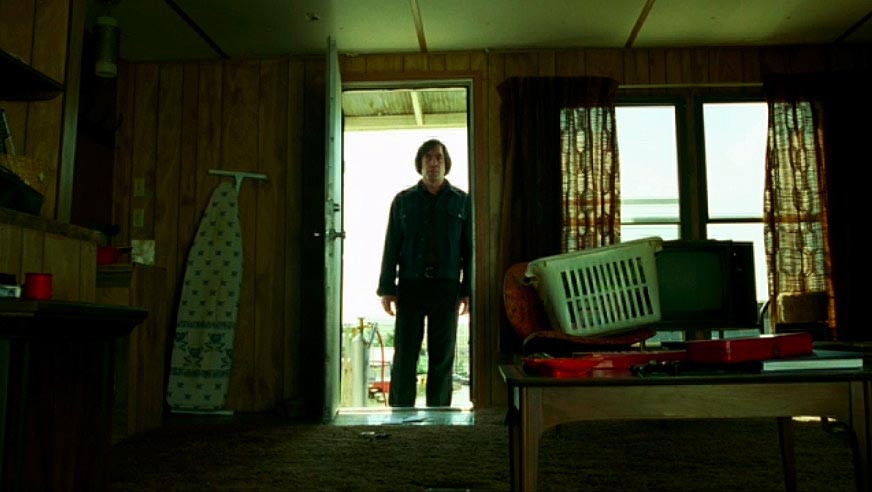
Crossing the threshold.

“Hold still.”
The sense of intimate incursion is especially unsettling when he enters the trailer of Llewelyn and Carla Jean. We’ve been here before, the night Llewelyn comes home from his hunt, seen him take a beer out of the refrigerator and plop down on the couch (shot head-on) next to Carla Jean. It’s a funny, “Raising Arizona” kind of domestic image. But when Chigurh enters this mobile home in the daylight, after they’ve fled, we watch him take a bottle of milk from the fridge and sit down in the center of the couch from nearly the same camera angles. He’s insinuating himself into their head-space. He drinks their milk, and it’s obscene. He may as well be drinking their blood. (Later, a cat drinking a puddle of spilled milk will provide all the visual information we need to know that there’s a corpse in a pool of blood behind a hotel counter. And it’s more upsetting than seeing the gory details.) Moments after Chigurh has disappeared, Sheriff Bell and Deputy Wendell arrive to inspect the scene, but this time the angles are different. We’re just seeing what they see, and nothing more.
Sheriff Ed Tom Bell is reluctantly playing catch-up throughout the whole picture. Moss and Chigurh — single-minded, driven — are linked at the beginning of the movie, with two shots (cinematic shots and fired shots) and the phrase, spoken to an anonymous victim: “Hold still.” In “No Country For Old Men,” that’s what the dead do. If you’re alive, you keep moving.
Brief notes on a few other motifs that permeate the movie:
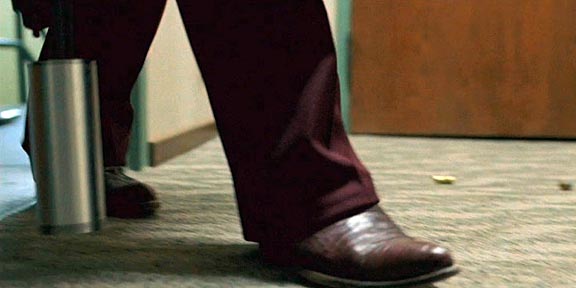

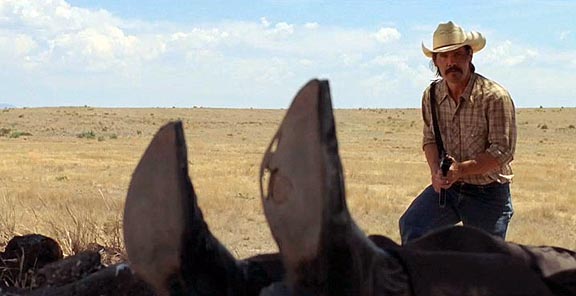
A sole at hazard.
Boots on the ground. Many shots of feet, from overhead or boot-level. You can’t quite tell where they’re going or what may intersect their path. Apprehension builds: What will appear in the frame next? A spreading pool of blood, perhaps? Also, the sense of gravity, of flesh in contact with the ground, or leather in contact with the land, weighs heavily in the film. (In what at first appears to be a surreal mirage, we actually see through the holes in a dead man’s soles, a man who has run until he dropped.) Chigurh is strongly identified with the ground, the craziness and violence rooted in and rising up from below the surface (natural and man-made).

If it bleeds, it leads.
Trails of blood. Blood is spilled upon the earth, but is also in the earth, as men are of the earth and will return to it. You half expect blood to seep up from the ground like Texas oil, this land is so saturated with ancient blood. Blood serves as a sign — a mark upon the land of some wound, and a portent of the future. Men follow trails of blood to unknown , or are followed by the blood they leave in their tracks.

Shadow in the doorway.

Hole to hell.
Doors, ducts, drains, holes. Take these portals, passages, barriers, hiding places, out of the movie and it’s about 20 minutes long. They’re all about revealing evidence or disposing of it. What is behind the door? What does one see — from either side — when the door opens? One of the movie’s signature shots is the “Searchers”-like figure silhouetted in the doorway, the outsider on the threshold between civilization (in the form of trailer or motel) and wilderness. Chigurh blows the deadbolt locks out of doors to get them open, using a slaughterhouse implement that leaves holes (in human heads, too) but no telltale shell or bullet behind. When Sheriff Bell returns to the scene of a crime and decides to face the incomprehensible, air sucks through a blown lock as if it were a puncture in the wall of hell. The Coens have always been plumbing experts, and here they use it exceptionally effectively. Cool, white porcelain fixtures contrast with swollen, bloody wounds. Flesh hurts.
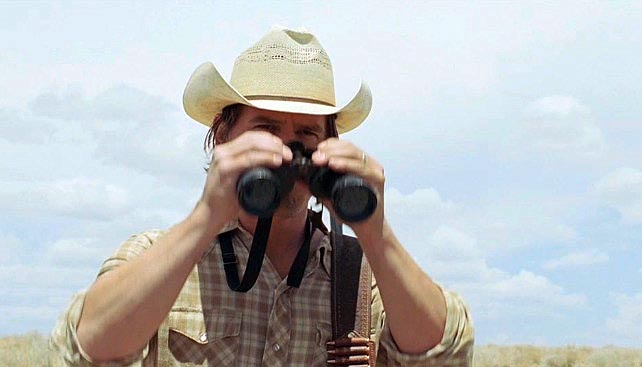
Looking and seeing.
Looking and seeing. A man looks at something. We see what he’s seeing: a herd of antelope through the scope of a rifle; two trees, the only shade for miles; an empty room. We return to his face, appraising the sight. It’s a simple POV set-up (a form of what David Bordwell calls “intensified continuity“) and it’s a familiar unit of American film grammar. It also essential to the experience of this particular movie: seeing (or not seeing) what’s ahead, surveying it, understanding it, acting on what you understand, and maybe not seeing what (or what else) is coming.
Running through all of the above are recurring spoken lines about “pre-visioning” the future, as Carla Jean’s mom puts it: “Will there be anything else?” “You don’t understand.” “Do you know where I’m going?” “You know what’s going to happen now.” “You know how this is going to turn out, don’t you?” “This is what will come to pass.” “You don’t know to a certainty.” “You can’t stop what’s comin’.”… Even the most mundane conversation may have ominous overtones, and they take on the haunting quality of blank-verse incantations.

Rendezvous with…
Because “No Country” is structured as a multi-layered chase sequence — Moss chasing the dream of a big lucky score; Chigurh chasing Moss; Carson Wells (Woody Harrelson) and Sheriff Bell independently chasing Chigurh through Moss; everyone chasing the unseen future of whatever’s next — you may not realize, until it’s all over, that we never see any of the three main characters (Moss, Chigurh, Bell) in direct, face-to-face confrontation. The closest they come is a near-collision of Chigurh’s boots and Moss’s pickup truck on a dark street.
The movie seems to be building to an apocalyptic climax… and the big bang is not so much a whimper as an ominous whisper. Wells is dispatched almost peripherally, with his back to the camera. Chigurh slips off into a suburban neighborhood, his fate unaccounted for. And Ed Tom retires quietly to his kitchen, recalling two dreams that came to him in one a night:
Both had my father. It’s peculiar. I’m older now’n he ever was by twenty years. So in a sense he’s the younger man. Anyway, first one I don’t remember so well but it was about money and I think I lost it.
The second one, it was like we was both back in older times and I was on horseback goin through the mountains of a night, goin through this pass in the mountains. It was cold and snowin, hard ridin. Hard country. He rode past me and kept on goin. Never said nothin goin by. He just rode on past and he had his blanket wrapped around him and his head down, and when he rode past I seen he was carryin fire in a horn the way people used to do and I could see the horn from the light inside of it. About the color of the moon. And in the dream I knew that he was goin on ahead and that he was fixin to make a fire somewhere out there in all that dark and all that cold, and I knew that whenever I got there he would be there. Out there up ahead.
And then I woke up.
I can’t imagine a more perfect and eloquent conclusion for this film, which begins and ends by acknowledging Ed Tom’s dreams and illusions, but some audiences have been vocal in their disapproval. What does the ending do? For one thing, it shows us a man who has retired, who has said he will not be part of the world he described in the opening, and who now sits indoors, in a cozy kitchen, where the wild outside is just a view through a window.
And yet, he’s still comparing himself to the “old-timers,” and still coming up short. It follows another scene in a kitchen, swarming with feral cats, belonging to Ed Tom’s cousin (and his granddad’s former deputy), Ellis, who sits in a wheelchair, having been shot by a man who died in prison. “What you got ain’t nothin new,” old Ellis tells Ed Tom, trying to shake him loose from his nostalgia. “This contry is hard on people…. You can’t stop what’s comin. Ain’t all waiting on you. That’s vanity.”
Ed Tom had his moment (in the scene before this one), when he crossed the yellow tape and entered the blue door of the dark motel room. Inside: Nothing. Just a loose vent and a dime — a coin tossed. Heads. Chigurh disappeared into the shadows… of the room next door. And that was it for ol’ Ed Tom — the most he ever put up on a coin toss, and the most he ever will if he can help it.
So, we go out on accounts of two dreams. The first one, about lost money — could be about a coin toss, or $2 million, or any number of things. But it’s about loss. Maybe the loss of the way Ed Tom looked at the world, and his relationship to it, in his opening monologue. Or maybe it’s just that he’s discouraged, and now retired.
The dream about the father is also many things, but it’s definitely “The Road,” McCarthy’s 2007 post-apocalyptic novel about a father carrying the fire to keep his son alive in a world of desolation. Ed Tom is now older than his father ever was, but in his dream his father is still out there, ahead of him, keeping the fire going in all that dark and all that cold. I read that (as I do the final paragraph of “The Road,” about the trout) as a sign that there is something to put up against the darkness, and maybe that’s all there is: that hope.
Then you wake up.
– – – – –
Quotations from a November 28, 2005, draft of the screenplay, found online during the writing of this article. The punctuation (no apostrophes for dropped letters at the end of words) mirrors Cormac McCarthy’s style.
Frame grabs taken from online trailers and TV spots.
Thanks to Peet Gelderblom for the Godard and Lynch quotes at 24 Lies A Second.







